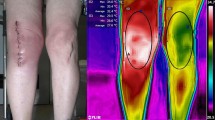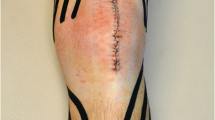Abstract
Purpose
During wound healing after surgery, physiological inflammation leads to an increase in soft tissue perfusion. This is reflected by a characteristic temperature course in the skin. Although local surgical trauma also influences soft tissue perfusion, no data have been available on the regional temperature distribution after knee arthroplasty to date. This study aims at testing the hypothesis that the greatest regional difference in the temperature course is on the site of the maximum surgical trauma (medially) after knee arthroplasty implantation. This is to our knowledge the first study to present regional differences in the temperature course after TKA which would limit the diagnostic value of thermography.
Methods
Forty-two subjects who were to receive a surface replacement of the knee joint due to primary varus gonarthrosis were included in the study. In all cases, a medial parapatellar approach was chosen. Patients who underwent lateral release or a release of the lateral ligament structures were excluded. In all patients, a thermographic temperature determination was carried out on the operated knee joint every day up to the seventh post-operative day.
Results
On the medial side, there was no significant change in temperature between day one 34.9° ± 0.2° (34.6–35.3 °C) and seven after surgery. Thereafter, the temperature remained constant here up to the seventh day after the operation. In contrast to this, on the lateral side there was an increase in skin temperature from the second 35.0 ± 0.2 °C (34.7–35.4 °C) to the fifth 34.6° ± 0.2° (34.1–34.9 °C) post-operative day (p = 0.002). Thereafter, the temperature remained constant here up to the seventh day after the operation.
Conclusion
This study refutes the hypothesis that the greatest regional difference in the temperature course is on the site of maximum surgical trauma (medially) after knee arthroplasty implantation. It is shown to the contrary that there is the least regional difference in the temperature course on the site of maximum surgical trauma (medially) after total knee arthroplasty implantation. It is on the site of the minimal trauma (laterally) where marked differences in the temperature course appeared. The normal temporary temperature increase typical of physiological wound healing could only be shown at a distance from the site of soft tissue preparation. This may be the result of a local compromise of perfusion. Consequently, the post-operative diagnostic application of thermography remains limited to regions distant from the surgical site. This may prevent misinterpretation of post-operative thermographic measurements for scientific or clinical reasons.
Level of evidence
II.




Similar content being viewed by others
References
Alcelik I, Sukeik M, Pollock R, Misra A, Shah P, Armstrong P, Dhebar MI (2012) Comparison of the minimally invasive and standard medial parapatellar approaches for primary total knee arthroplasty. Knee Surg Sports Traumatol Arthrosc 20:2502–2512
Aso K, Ikeuchi M, Izumi M, Kato T, Tani T (2012) Transcutaneous oxygen tension in the anterior skin of the knee after minimal incision total knee arthroplasty. Knee 19:576–579
Choudhry RR, Rice RP, Triffitt PD, Harper WM, Gregg PJ (1992) Plasma viscosity and C-reactive protein after total hip and knee arthroplasty. J Bone Jt Surg Br 74:523–524
Haidar SG, Charity RM, Bassi RS, Nicolai P, Singh BK (2006) Knee skin temperature following uncomplicated total knee replacement. Knee 13:422–426
Hazenberg CEVB, van Netten JJ, van Baal SG, Bus SA (2014) Assessment of signs of foot infection in diabetes patients using photographic foot imaging and infrared thermography. Diabet Technol Ther 16:370–377
Honsawek S, Deepaisarnsakul B, Tanavalee A, Sakdinakiattikoon M, Ngarmukos S, Preativatanyou K, Bumrungpanichthaworn P (2011) Relationship of serum IL-6, C-reactive protein, erythrocyte sedimentation rate, and knee skin temperature after total knee arthroplasty: a prospective study. Int Orthop 35:31–35
Horzić M, Marić K, Bunoza D (1995) The temperature dynamics during the healing processing of a surgical wound. Biomed Tech (Berl) 40:106–109
Ishii Y, Noguchi H, Takeda M, Higashihara T-I (2009) A new tourniquet system that determines pressures in synchrony with systolic blood pressure in knee surgery. Knee Surg Sports Traumatol Arthrosc 17:48–52
Johnson DP (1988) Midline or parapatellar incision for knee arthroplasty. A comparative study of wound viability. J Bone Jt Surg Br 70:656–658
Kliot DA, Birnbaum SJ (1965) Thermographic studies of wound healing. Am J Obstet Gynecol 93:515–521
Lambiris E, Stoboy H (1981) Thermography in osteosyntheses and total endoprostheses of the knee joint with and without infection (author’s transl). Z Orthop Ihre Grenzgeb 119:521–524
Larsson S, Thelander U, Friberg S (1992) C-reactive protein (CRP) levels after elective orthopedic surgery. Clin Orthop Relat Res 275:237–242
Mehra A, Langkamer VG, Day A, Harris S, Spencer RF (2005) C reactive protein and skin temperature post total knee replacement. Knee 12:297–300
Neĭkov GN, Mingazov IT (1993) Comparative assessment of methods in early diagnosis of acute hematogenic osteomyelitis in children. Klin Khir 3:47–49
Ring EF (1987) Thermographic and scintigraphic examination of the early phase of inflammatory disease. Scand J Rheumatol Suppl 65:77–80
Ring EFJ (2004) The historical development of thermal imaging in medicine. Rheumatol (Oxford) 43:800–802
Robicsek F, Masters TN, Daugherty HK, Cook JW, Selle JG, Hess PJ, Vajtai P (1984) The value of thermography in the early diagnosis of postoperative sternal wound infections. Thorac Cardiovasc Surg 32:260–265
Romanò CL, D’Anchise R, Calamita M, Manzi G, Romanò D, Sansone V (2013) Value of digital telethermography for the diagnosis of septic knee prosthesis: a prospective cohort study. BMC Musculoskelet Disord 14:7
Romanò CL, Logoluso N, Dell’Oro F, Elia A, Drago L (2012) Telethermographic findings after uncomplicated and septic total knee replacement. Knee 19:193–197
Romanò CL, Romanò D, Dell’Oro F, Logoluso N, Drago L (2011) Healing of surgical site after total hip and knee replacements show similar telethermographic patterns. J Orthop Traumatol 12:81–86
Thienpont E, Grosu I, Jonckheere S, Yombi JC (2013) C-reactive protein (CRP) in different types of minimally invasive knee arthroplasty. Knee Surg Sports Traumatol Arthrosc 21:2603–2610
White J, Kelly M, Dunsmuir R (1998) C-reactive protein level after total hip and total knee replacement. J Bone Jt Surg Br 80:909–911
www.flir.com/ FLIR i3. Technical specifications
Author information
Authors and Affiliations
Corresponding author
Additional information
An erratum to this article is available at http://dx.doi.org/10.1007/s00167-017-4456-3.
Rights and permissions
About this article
Cite this article
Windisch, C., Brodt, S., Roehner, E. et al. Regional differences in temperature course after knee arthroplasty. Knee Surg Sports Traumatol Arthrosc 24, 2686–2691 (2016). https://doi.org/10.1007/s00167-015-3809-z
Received:
Accepted:
Published:
Issue Date:
DOI: https://doi.org/10.1007/s00167-015-3809-z




